Commonwealth of the Philippines
The Commonwealth of the Philippines (Spanish: Commonwealth de Filipinas;[1] Tagalog: Komonwelt ng Pilipinas[3] or Malasariling Pamahalaan ng Pilipinas[4]) was the administrative body that governed the Philippines from 1935 to 1946, aside from a period of exile in the Second World War from 1942 to 1945 when Japan occupied the country. It replaced the Insular Government, a United States territorial government, and was established by the Tydings–McDuffie Act. The Commonwealth was designed as a transitional administration in preparation for the country's full achievement of independence.[10] Its foreign affairs remained managed by the United States.[11]
| 1935–1942 Japanese occupation: 1942–45 1945–1946 | |||||||||||||
 Coat of arms
| |||||||||||||
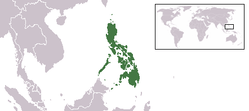 Location of the Philippines in Southeast Asia. | |||||||||||||
| Status | Associated state and protectorate of the United States | ||||||||||||
| Capital | Manilaa | ||||||||||||
| Common languages | |||||||||||||
| Religion | Roman Catholicism | ||||||||||||
| Government | Unitary presidential constitutional republic under a commonwealth | ||||||||||||
| President | |||||||||||||
• 1935–44 | Manuel L. Quezon | ||||||||||||
• 1944–46 | Sergio Osmeña | ||||||||||||
• 1946 | Manuel Roxas | ||||||||||||
| High Commissioner | |||||||||||||
• 1935–37 | Frank Murphy | ||||||||||||
• 1937–39 | Paul V. McNutt | ||||||||||||
• 1939–42 | Francis Bowes Sayre | ||||||||||||
• 1945–46 | Paul V. McNutt | ||||||||||||
| Vice President | |||||||||||||
• 1935–44 | Sergio Osmeña | ||||||||||||
• 1946 | Elpidio Quirino | ||||||||||||
| Legislature |
| ||||||||||||
| Historical era | Interwar, World War II | ||||||||||||
• Tydings–McDuffie Act | November 15, 1935[6][7][8][9] | ||||||||||||
• Independence | July 4, 1946 | ||||||||||||
• Treaty of Manila | October 22, 1946 | ||||||||||||
| Area | |||||||||||||
| 1939 | 343,385.1 km2 (132,581.7 sq mi) | ||||||||||||
| Population | |||||||||||||
• 1939 | 16,000,303 | ||||||||||||
| Currency | Peso | ||||||||||||
| Driving side | left (before 1945) right (after 1945) | ||||||||||||
| |||||||||||||
| Today part of | |||||||||||||
| |||||||||||||
During its more than a decade of existence, the Commonwealth had a strong executive and a Supreme Court. Its legislature, dominated by the Nacionalista Party, was at first unicameral, but later bicameral. In 1937, the government selected Tagalog – the language of Manila and its surrounding provinces – as the basis of the national language, although it would be many years before its usage became general. Women's suffrage was adopted and the economy recovered to its pre-Depression level before the Japanese occupation in 1942.
The Commonwealth government went into exile from 1942 to 1945, when the Philippines was under Japanese occupation. In 1946, the Commonwealth ended and the Philippines claimed full sovereignty as provided for in Article XVIII of the 1935 Constitution.[12]
Names
The Commonwealth of the Philippines was also known as the "Philippine Commonwealth",[13][14] or simply as "the Commonwealth". It had official names in Tagalog: Kómonwélt ng Pilipinas ([pɪlɪˈpinɐs]) and Spanish: Commonwealth de Filipinas ([filiˈpinas]). The 1935 Constitution specifies "the Philippines" as the country's short-form name and uses "the Philippine Islands" only to refer to pre-1935 status and institutions.[12] Under the Insular Government (1901–1935), both terms had official status.[lower-alpha 1][15]
History
Part of a series on the |
|---|
| History of the Philippines |
 |
|
Prehistory (pre–900) Paleolithic age
Events/Artifacts
|
|
Archaic epoch (900–1565) Historically documented city-states/polities
(by geography from North to South)
Legendary
Events/Artifacts
|
|
Colonial period (1565–1946) Spanish era
|
|
Post-colonial period (1946–1986)
|
|
Contemporary history (1986–present)
|
|
By topic
|
| Timeline |
| Archaeology |
|
|
Creation
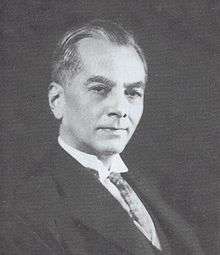
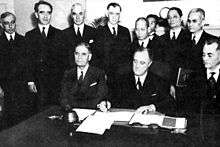
The pre-1935 U.S. territorial administration, or Insular Government, was headed by a governor general who was appointed by the president of the United States. In December 1932, the U.S. Congress passed the Hare–Hawes–Cutting Act with the premise of granting Filipinos independence. Provisions of the bill included reserving several military and naval bases for the United States, as well as imposing tariffs and quotas on Philippine exports.[16][17] When it reached him for possible signature, President Herbert Hoover vetoed the Hare–Hawes–Cutting Act, but the American Congress overrode Hoover's veto in 1933 and passed the bill over Hoover's objections.[18] The bill, however, was opposed by the then-Philippine Senate President Manuel L. Quezon and was also rejected by the Philippine Senate.[19]
This led to the creation and passing of a new bill known as the Tydings–McDuffie Act[lower-alpha 2] or the Philippine Independence Act, which allowed the establishment of the Commonwealth of the Philippines with a ten-year period of peaceful transition to full independence – the date of which was to be on the 4th of July following the tenth anniversary of the establishment of the Commonwealth.[16][20][21]
A Constitutional Convention was convened in Manila on July 30, 1934. On February 8, 1935, the 1935 Constitution of the Commonwealth of the Philippines was approved by the convention by a vote of 177 to 1. The constitution was approved by President Franklin D. Roosevelt on March 23, 1935, and ratified by popular vote on May 14, 1935.[22][23]
On 16 September 1935,[6] presidential elections were held. Candidates included former president Emilio Aguinaldo, the Iglesia Filipina Independiente leader Gregorio Aglipay, and others. Manuel L. Quezon and Sergio Osmeña of the Nacionalista Party were proclaimed the winners, winning the seats of president and vice-president, respectively.[16]
The Commonwealth government was inaugurated on the morning of November 15, 1935, in ceremonies held on the steps of the Legislative Building in Manila. The event was attended by a crowd of around 300,000 people.[6]
Pre-War
The new government embarked on ambitious nation-building policies in preparation for economic and political independence.[16] These included national defense (such as the National Defense Act of 1935, which organized a conscription for service in the country), greater control over the economy, the perfection of democratic institutions, reforms in education, improvement of transport, the promotion of local capital, industrialization, and the colonization of Mindanao.
However, uncertainties, especially in the diplomatic and military situation in Southeast Asia, in the level of U.S. commitment to the future Republic of the Philippines, and in the economy due to the Great Depression, proved to be major problems. The situation was further complicated by the presence of agrarian unrest, and of power struggles between Osmeña and Quezon,[16] especially after Quezon was permitted to be re-elected after one six-year term.
A proper evaluation of the policies' effectiveness or failure is difficult due to Japanese invasion and occupation during World War II.
World War II
Japan launched a surprise attack on the Philippines on December 8, 1941. The Commonwealth government drafted the Philippine Army into the U.S. Army Forces Far East, which would resist Japanese occupation. Manila was declared an open city to prevent its destruction,[24] and it was occupied by the Japanese on January 2, 1942.[25] Meanwhile, battles against the Japanese continued on the Bataan Peninsula, Corregidor, and Leyte until the final surrender of United States-Philippine forces in May 1942.[26]
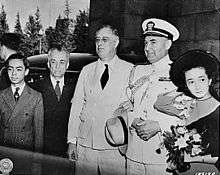
Quezon and Osmeña were escorted by troops from Manila to Corregidor, and later left for Australia prior to going to the U.S., where they set up a government in exile, based at the Shoreham Hotel, in Washington, D.C.[27] This government participated in the Pacific War Council as well as the Declaration by United Nations. Quezon became ill with tuberculosis and died from it, with Osmeña succeeding him as president.
The main general headquarters of the Philippine Commonwealth Army (PCA), located on the military station in Ermita, Manila, was closed down on December 24, 1941. Upon arrival of the Japanese Imperial forces which occupied Manila on January 2, 1942, the defunct PCA main headquarters in the capital city was occupied as the Japanese assumed control. Subsequent to commencement of the Japanese occupation, from January 3, 1942 to June 30, 1946, during and after the Second World War, the general headquarters and military camps and bases of the PCA military stations in the main provinces of the Philippine Archipelago from Luzon, Visayas and Mindanao were openly under control of the PCA service and began local military conflicts and to engage operations against the Japanese Occupation in this country.
Meanwhile, the Japanese military organized a new government in the Philippines known as the Second Philippine Republic, headed by president José P. Laurel. This pro-Japanese government became very unpopular.[28]
Resistance to the Japanese occupation continued in the Philippines. This included the Hukbalahap ("People's Army Against the Japanese"), which consisted of 30,000 armed men and controlled much of Central Luzon;[28] they attacked both the Japanese and other non-Huk guerrillas.[29] Remnants of the Philippine Army, as well as unsurrendered Americans, also successfully fought the Japanese through guerrilla warfare.[30] These efforts eventually liberated all but 12 of the 48 provinces.[28]

General Douglas MacArthur's army landed on Leyte on October 20, 1944,[16] as well as the Philippine Commonwealth troops who arrived in other amphibious landings. The Philippine Constabulary was placed on active service with the Philippine Commonwealth Army and re-established on October 28, 1944, to June 30, 1946, during the Allied liberation to Post-World War II era. Fighting continued in remote corners of the Philippines until Japan's surrender in August 1945, which was signed on September 2 in Tokyo Bay. Estimates of Filipino war dead reached one million, and Manila was extensively damaged when Japanese marines refused to vacate the city when ordered to do so by the Japanese High Command.[31] After the war in the Philippines, the Commonwealth was restored and a one-year transitional period in preparation for independence began. Elections followed in April 1946 with Manuel Roxas winning as the first president of the independent Republic of the Philippines and Elpidio Quirino winning as vice-president.
Independence
The Commonwealth ended when the U.S. recognized Philippine independence on July 4, 1946, as scheduled.[32][33] However, the economy remained dependent on the U.S.[34] This was due to the Bell Trade Act, otherwise known as the Philippine Trade Act, which was a precondition for receiving war rehabilitation grants from the United States.[35]
Policies
Uprisings and agrarian reform
During the Commonwealth period, tenant farmers held grievances often rooted to debt caused by the sharecropping system, as well as by the dramatic increase in population, which added economic pressure to the tenant farmers' families.[36] As a result, an agrarian reform program was initiated by the Commonwealth. However, success of the program was hampered by ongoing clashes between tenants and landowners.
An example of these clashes includes one initiated by Benigno Ramos through his Sakdalista movement,[37] which advocated tax reductions, land reforms, the breakup of the large estates or haciendas, and the severing of American ties. The uprising, which occurred in Central Luzon in May 1935, claimed about a hundred lives.
National language
The Commonwealth had two official languages; Spanish, and English.[5] Due to the diverse number of Philippine languages, a program for the "development and adoption of a common national language based on the existing native dialects" was drafted in the 1935 Constitution.[38] The Commonwealth created the Surián ng Wikang Pambansà (National Language Institute), which was initially composed of President Quezon and six other members from various ethnic groups. A deliberation was held and Tagalog,[38] due to its extensive literary tradition, was selected as the basis for the "national language" to be called "Pilipino".
In 1940, the Commonwealth authorized the creation of a dictionary and grammar book for the language. In that same year, Commonwealth Act 570 was passed, allowing Filipino to become an official language upon independence.[38]
Economy
The cash economy of the Commonwealth was mostly agriculture-based. Products included abaca, coconuts and coconut oil, sugar, and timber.[39] Numerous other crops and livestock were grown for local consumption by the Filipino people. Other sources for foreign income included the spin-off from money spent at American military bases on the Philippines such as the naval base at Subic Bay and Clark Air Base (with U.S. Army airplanes there as early as 1919), both on the island of Luzon.
The performance of the economy was initially good despite challenges from various agrarian uprisings. Taxes collected from a robust coconut industry helped boost the economy by funding infrastructure and other development projects. However, growth was halted due to the outbreak of World War II.[39]
Demographics
In 1939, a census of the Philippines was taken and determined that it had a population of 16,000,303; of these 15.7 million were counted as "Brown", 141.8 thousand as "Yellow", 19.3 thousand as "White", 29.1 thousand as "Negro", 50.5 thousand as "Mixed", and under 1 thousand "Other".[40] In 1941, the estimated population of the Philippines reached 17,000,000; there were 117,000 Chinese, 30,000 Japanese, and 9,000 Americans.[41] English was spoken by 26.3% of the population, according to the 1939 Census.[42] Spanish, after English overtook it beginning in the 1920s, became a language for the elite and in government; it was later banned during the Japanese occupation.[43]
Estimated numbers of speakers of the dominant languages:[38]
- Cebuano: 4,620,685
- Tagalog: 3,068,565
- Ilocano: 2,353,518
- Hiligaynon: 1,951,005
- Waray: 920,009
- Kapampangan: 621,455
- Pangasinan: 573,752
Government
The Commonwealth had its own constitution, which remained effective until 1973,[44] and was self-governing[12] although foreign policy and military affairs would be under the responsibility of the United States, and Laws passed by the legislature affecting immigration, foreign trade, and the currency system had to be approved by the United States president.[11]
During the 1935–41 period, the Commonwealth of the Philippines featured a very strong executive, a unicameral National Assembly,[45][46] and a Supreme Court,[47] all composed entirely of Filipinos, as well as an elected Resident Commissioner to the United States House of Representatives (as Puerto Rico does today). An American High Commissioner and an American Military Advisor,[32] Douglas MacArthur headed the latter office from 1937 until the advent of World War II in 1941, holding the military rank of Field Marshal of the Philippines. After 1946, the rank of field marshal disappeared from the Philippine military.
During 1939 and 1940, after an amendment in the Commonwealth's Constitution, a bicameral Congress,[48] consisting of a Senate,[48] and of a House of Representatives,[48] was restored, replacing the National Assembly.[48]
Politics
List of presidents
The colors indicate the political party or coalition of each President at Election Day.
| # | President | Took office | Left office | Party | Vice President | Term | |
|---|---|---|---|---|---|---|---|
| 1 | Manuel L. Quezon | November 15, 1935 | August 1, 19441 | Nacionalista | Sergio Osmeña | 1 | |
| 2 | |||||||
| 2 | Sergio Osmeña | August 1, 1944 | May 28, 1946 | Nacionalista | vacant | ||
| 3 | Manuel Roxas | May 28, 1946 | July 4, 19462 | Liberal | Elpidio Quirino | 3 | |
1 Died of tuberculosis at Saranac Lake, New York.
2 End of Commonwealth government, independent Republic inaugurated.
Quezon Administration (1935–44)
.jpg)
In 1935 Quezon won the Philippines' first national presidential election under the banner of the Nacionalista Party. He obtained nearly 68% of the vote against his two main rivals, Emilio Aguinaldo and Bishop Gregorio Aglipay.[49] Quezon was inaugurated in November 1935.[50] He is recognized as the second President of the Philippines.[51] When Manuel L. Quezon was inaugurated President of the Philippines in 1935, he became the first Filipino to head a government of the Philippines since Emilio Aguinaldo and the Malolos Republic in 1898. However, in January 2008, Congressman Rodolfo Valencia of Oriental Mindoro filed a bill seeking instead to declare General Miguel Malvar as the second Philippine President, who took control over all Filipino forces after American soldiers captured President Emilio Aguinaldo in Palanan, Isabela on 23 March 1901.[52]
Quezon had originally been barred by the Philippine constitution from seeking re-election. However, in 1940, constitutional amendments were ratified allowing him to seek re-election for a fresh term ending in 1943.[53] In the 1941 presidential elections, Quezon was re-elected over former Senator Juan Sumulong with nearly 82% of the vote.[54]
In a notable humanitarian act, Quezon, in cooperation with U.S. High Commissioner Paul V. McNutt, facilitated the entry into the Philippines of Jewish refugees fleeing fascist regimes in Europe. Quezon was also instrumental in promoting a project to resettle the refugees in Mindanao.[55]
Quezon suffered from tuberculosis and spent his last years in a 'cure cottage' in Saranac Lake, NY, where he died on August 1, 1944.[56] He was initially buried in Arlington National Cemetery. His body was later carried by the USS Princeton[57] and re-interred in Manila at the Manila North Cemetery before being moved to Quezon City within the monument at the Quezon Memorial Circle.[58]
Osmeña Administration (1944–46)
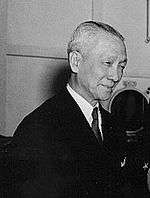
Osmeña became president of the Commonwealth on Quezon's death in 1944.[59] He returned to the Philippines the same year with General Douglas MacArthur and the liberation forces.[60] After the war Osmeña restored the Commonwealth government and the various executive departments. He continued the fight for Philippine independence.
For the presidential election of 1946 Osmeña refused to campaign, saying that the Filipino people knew of his record of 40 years of honest and faithful service.[61] Nevertheless, he was defeated by Manuel Roxas, who won 54% of the vote and became the first president of the independent Republic of the Philippines.[59]
Roxas Administration (May 28, 1946 – July 4, 1946)
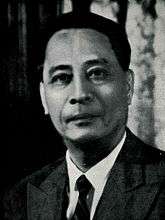
Roxas served as the President of the Commonwealth of the Philippines in a brief period, from his subsequent election on May 28, 1946 to July 4, 1946, the scheduled date of the proclamation of Philippine Independence.[62] Roxas prepared the groundwork for the advent of a free and independent Philippines, assisted by the Congress (reorganized May 25, 1946), with Senator José Avelino as the Senate President and Congressman Eugenio Pérez as the House of Representatives Speaker.[63] On June 3, 1946, Roxas appeared for the first time before the joint session of the Congress to deliver his first state of the nation address. Among other things, he told the members of the Congress the grave problems and difficulties the Philippines were set to face and reported on his special trip to the U.S. — the approval for independence.[64]
On June 21, he reappeared in another joint session of the Congress and urged the acceptance of two important laws passed by the U.S. Congress on April 30, 1946, regarding the Philippine lands. They are the Philippine Rehabilitation Act and the Philippine Trade Act.[65] Both recommendations were accepted by the Congress.
See also
- Commonwealth (U.S. insular area)
- Political history of the Philippines
- History of the Philippines
- Philippine Organic Act (1902)
- Jones Law (Philippines) Philippines Organic Act (1916)
- Treaty of Paris (1898)
- Filipino Repatriation Act of 1935
- Hare–Hawes–Cutting Act (1932)
Notes
- See for example, the Jones Law of 1916, which uses "Philippines" and "Philippine Islands" interchangeably.
- Officially, the Philippine Independence Act; Pub.L. 73–127; approved on March 24, 1934.
References
- "Official Ballot". Presidential Museum and Library. Retrieved July 12, 2017.
Officials of the Commonwealth of the Philippines – Funcionarios del Commonwealth de Filipinas
- Article XIV, Section 10, of the Constitution of the Commonwealth of the Philippines which reads "[t]his Constitution shall be officially promulgated in English and Spanish, but in case of conflict the English text shall prevail."
- "Constitutional Law". Philconsa Yearbook. Philippine Constitution Association. 1965. Retrieved September 26, 2014."Balangkas at Layunin ng Pamahalaang Komonwelt". Bureau of Elementary Education. Department of Education. 2010. Archived from the original on August 16, 2016. Retrieved September 26, 2014.
- "Pilipinas, Bayang Minamahal 5' 2003 Ed". 2003. Retrieved November 5, 2019. Cite journal requires
|journal=(help) - Mair, Christian (2003). The politics of English as a world language: new horizons in postcolonial cultural studies. NL: Rodopi. pp. 479–82. ISBN 978-90-420-0876-2. Retrieved February 17, 2011. 497 pp.
Roger M. Thompson (January 1, 2003). Filipino English and Taglish: Language Switching from Multiple Perspectives. John Benjamins Publishing. pp. 27–29. ISBN 90-272-4891-5.
Christian Mair (January 1, 2003). The Politics of English as a World Language: New Horizons in Postcolonial Cultural Studies. Rodopi. p. 480. ISBN 90-420-0876-8.
Antonio L. Rappa; Lionel Wee Hock An (February 23, 2006). Language Policy and Modernity in Southeast Asia: Malaysia, the Philippines, Singapore, and Thailand. Springer Science & Business Media. p. 68. ISBN 978-1-4020-4510-3. - Timeline 1930–1939, PH: St. Scholastica's College.
- Gin Ooi 2004, p. 387.
- Zaide 1994, p. 319.
- Roosevelt, Franklin D (November 14, 1935), "Proclamation 2148 on the Establishment of the Commonwealth of the Philippines", The American Presidency Project, the Commonwealth Road, consecrated on October 23, 1937, Santa Barbara: University of California,
This Proclamation shall be effective upon its promulgation at Manila, Philippine Islands, on November 15, 1935, by the Secretary of War of the United States of America, who is hereby designated as my representative for that purpose.
- Castro, Christi-Anne, Associate Professor University of Michigan (April 7, 2011). Musical Renderings of the Philippine Nation. U.S.: Oxford University Press. p. 204. ISBN 978-0-19-974640-8. Retrieved July 3, 2013.
- Seekins 1993, p. 39.
- "The 1935 Constitution". Official Gazette. Government of the Philippines. February 8, 1935.
- A Decade of American Foreign Policy 1941–1949 Interim Meeting of Foreign Ministers, Moscow: Yale, retrieved September 30, 2009.
- "The Philippine Commonwealth", The New York Times, November 16, 1935, retrieved October 1, 2009.
- Philippine Autonomy Act (Jones Law), The corpus juris, archived from the original on February 26, 2009.
- "Philippines, The period of U.S. influence". Encyclopædia Britannica (online ed.). Retrieved February 10, 2007.
- "Hare-Hawes-Cutting-Act". Encyclopædia Britannica (online ed.). Retrieved February 10, 2007.
- Agoncillo & Guerrero 1970, pp. 345–346
- Seekins 1993, pp. 38–39.
- "Tydings-McDuffie Act". Encyclopædia Britannica Online. Retrieved February 10, 2007.
- "Text of the Tydings-McDuffie Act". The ChanRobles Group. Retrieved February 10, 2007.
- Constitution of the Commonwealth of the Philippines, The corpus juris, 1935, archived from the original on May 22, 2009.
- Zaide 1994, pp. 317–18.
- Agoncillo & Guerrero 1970, p. 390.
- Agoncillo & Guerrero 1970, p. 392.
- Lacsamana 1990, p. 168.
- Agoncillo & Guerrero 1970, p. 415.
- Seekins 1993, pp. 40–41.
- Sinclair, II, Major Peter T. (December 1, 2011), "Men of Destiny: The American and Filipino Guerillas During the Japanese Occupation of the Philippines" (pdf), dtic.mil, School of Advanced Military Studies, United States Army Command and General Staff College, p. 35, retrieved September 2, 2014
- Willoughby, Charles A.; Prange, Gordon W. (June 20, 2006) [1966]. "Chapter X Guerrilla Activities in the Philippines". Reports of General MacArthur: The campaign of MacArthur in the Pacific Volume I. Center of Military History. LCCN 66-60005.
- Seekins 1993, p. 41.
- "Philippine History". DLSU-Manila. Archived from the original on August 22, 2006. Retrieved February 11, 2007.
- Weir 1998
- Seekins 1993, p. 43.
- "Balitang Beterano: Facts about Philippine Independence". Philippine Headline News Online. February 2004. Retrieved February 11, 2007.
- "Philippine history American Colony and Philippine Commonwealth (1901–1941)". Windows on Asia. MSU. Archived from the original on October 10, 2007. Retrieved February 11, 2007.
- Roces, Luna & Arcilla 1986, p. 140.
- Roces, Luna & Arcilla 1986, p. 338.
- "American Colony and Philippine Commonwealth (1901–1941)". Filipinas Heritage Library. Archived from the original on January 29, 2007. Retrieved February 12, 2007.
- "Statistical Abstract of the United States" (PDF). census.gov. United States Department of Commerce. 1941. Retrieved September 8, 2014.
- Bailey, Rayne (2009). Immigration and Migration. Infobase Publishing. p. 107. ISBN 978-1-4381-0901-5. Retrieved September 8, 2014.
- Thompson, Roger M. (2003). Filipino English and Taglish: Language Switching from Multiple Perspectives. John Benjamins Publishing. p. 27. ISBN 9789027248916. Retrieved September 7, 2014.
- Thompson, Roger M. (2003). Filipino English and Taglish: Language Switching from Multiple Perspectives. John Benjamins Publishing. p. 61. ISBN 9789027248916. Retrieved September 7, 2014.
- "Constitutions of the Philippines". The ChanRobles Group. Retrieved February 10, 2007.
- Agoncillo 2001.
- Hayden 1942.
- "The Yamashita Standard". PBS. Retrieved February 12, 2007.
- "A History of Plebiscites in the Philippines". Arab News. Retrieved February 12, 2007.
- INQUIRER.net. "Did you know: 1st national elections in PH held on Sept. 16, 1935". newsinfo.inquirer.net. Retrieved March 27, 2019.
- "Inaugural Address of President Manuel L. Quezon, November 15, 1935 | GOVPH". Official Gazette of the Republic of the Philippines. Retrieved March 27, 2019.
- "Manuel L. Quezon | Presidential Museum and Library". Retrieved March 27, 2019.
- Villegas, Bernardo (September 18, 2015). "My Lolo Miguel, the hero". Manila Bulletin. Retrieved March 27, 2019.
- III, Manuel L. Quezon. "OPINION: The vice-presidency: a briefer". ABS-CBN News. Retrieved March 27, 2019.
- "MLQ's colorful language". Manila Bulletin News. Retrieved March 27, 2019.
- Katz, Deborah. "Manuel L. Quezon, President Of The Philippines, Rescuer Of Jews". Retrieved March 27, 2019.
- Tan, Michael L. "Quezon and TB". opinion.inquirer.net. Retrieved March 27, 2019.
- Baron, Scott (January 14, 2019). Valor of Many Stripes: Remarkable Americans in World War II. McFarland. ISBN 978-1-4766-7441-4.
- "Museo ni Manuel Quezon". National Historical Commission of the Philippines. Retrieved March 27, 2019.
- "Sergio Osmeña | president of Philippines". Encyclopedia Britannica. Retrieved March 27, 2019.
- Lohr, Steve (October 20, 1984). "40 Years Later, Memories of Macarthur's Return". The New York Times. ISSN 0362-4331. Retrieved March 27, 2019.
- Mercado, Juan (September 2, 2012). "Boasting of ancestors". Sunstar Cebu. Retrieved March 27, 2019.
- "Manuel Roxas | president of Philippines". Encyclopedia Britannica. Retrieved March 27, 2019.
- "Manuel Roxas | Presidential Museum and Library". Retrieved March 27, 2019.
- "President Roxas on First State of the Nation Address, June 3, 1946 | GOVPH". Official Gazette of the Republic of the Philippines. Retrieved March 27, 2019.
- Official Gazette, 42, July 1946, pp. 1625–28.
Bibliography
- Philippine Legislature, 100 Years, Philippine Historical Association, New Day Publishers, 2000, ISBN 971-92245-0-9.
- Agoncillo, Teodoro A; Guerrero, Milagros (1970), History of the Filipino People, Malaya Books, retrieved December 28, 2007
- ——— (2001), The Fateful Years: Japan's Adventure in the Philippines 1941–1945, 1, Quezon City, PH: University of the Philippines Press, ISBN 978-971-542-274-1.
- Gin Ooi, Keat (2004), Southeast Asia: a historical encyclopedia, from Angkor Wat to East Timor, ABC-CLIO, ISBN 978-1-57607-770-2.
- Hayden, Joseph Ralston (1942), The Philippines, a Study in National Development, Macmillan, retrieved December 28, 2007.
- Lacsamana, Leodivico Cruz (1990), Philippine History and Government, Phoenix, ISBN 971-06-1894-6, retrieved December 28, 2007.
- Roces; Luna, Juan Luis Z Jr; Arcilla, Reynaldo (1986), RR Philippine almanac: book of facts, Ramon Roces y Pardo.
- Seekins, Donald M. (1993), "Historical Setting", in Dolan, Ronald E. (ed.), Philippines: A Country Study (4th ed.), Washington: GPO for the Library of Congress, pp. 1–63, ISBN 0-8444-0748-8.
- Weir, Fraser (1998), "American Colony and Philippine Commonwealth 1901–1941", A Centennial History of Philippine Independence, 1898–1998, retrieved December 28, 2007
- Zaide, Sonia M (1994), The Philippines: A Unique Nation, All-Nations, ISBN 971-642-071-4
External links
- Kalaw, Maximo, The Present Government of the Philippines (book), Filipiniana, archived from the original on February 12, 2009, retrieved December 23, 2008, detailing the functions of the different branches of the Philippine Commonwealth.
- Parallel and Divergent Aspects of British Rule in the Raj, French Rule in Indochina, Dutch Rule in the Netherlands East Indies (Indonesia), and American Rule in the Philippines, CA: House of David.
- Philippines: Polity Style: 1897–2009, Archontology.
- The Commonwealth of the Philippines, PH: Government.
.svg.png)
.svg.png)
